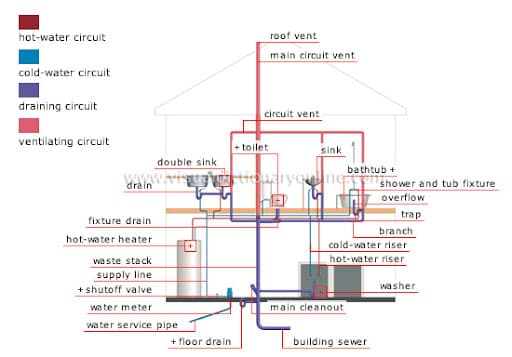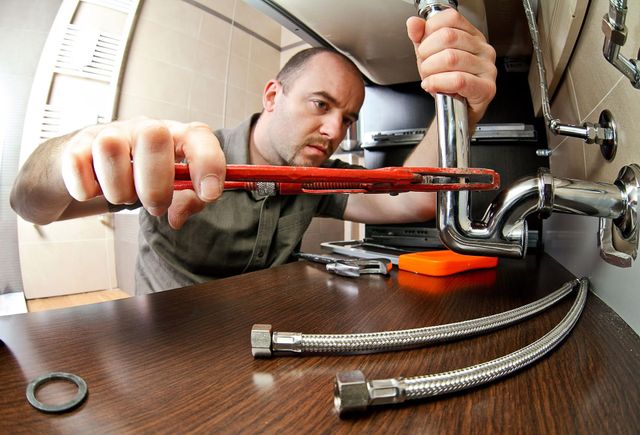Why Your Property's Plumbing System Works: Structure
Why Your Property's Plumbing System Works: Structure
Blog Article
They are making a number of great points on the subject of Anatomy of a House: Understanding the Components overall in this content down below.

Understanding exactly how your home's plumbing system functions is crucial for each home owner. From delivering clean water for alcohol consumption, cooking, and showering to safely eliminating wastewater, a well-maintained pipes system is critical for your family's health and convenience. In this comprehensive guide, we'll discover the intricate network that comprises your home's plumbing and deal suggestions on upkeep, upgrades, and dealing with usual concerns.
Introduction
Your home's plumbing system is more than simply a network of pipelines; it's a complex system that ensures you have access to tidy water and efficient wastewater removal. Understanding its parts and exactly how they collaborate can help you protect against costly repair work and ensure every little thing runs efficiently.
Standard Parts of a Pipes System
Pipelines and Tubes
At the heart of your pipes system are the pipes and tubing that bring water throughout your home. These can be constructed from various materials such as copper, PVC, or PEX, each with its benefits in terms of sturdiness and cost-effectiveness.
Components: Sinks, Toilets, Showers, and so on.
Fixtures like sinks, toilets, showers, and bath tubs are where water is utilized in your home. Understanding exactly how these fixtures attach to the plumbing system assists in identifying issues and intending upgrades.
Shutoffs and Shut-off Factors
Valves control the circulation of water in your plumbing system. Shut-off valves are critical during emergency situations or when you require to make fixings, enabling you to isolate parts of the system without interrupting water circulation to the entire residence.
Water Supply System
Key Water Line
The major water line connects your home to the metropolitan water or a private well. It's where water enters your home and is dispersed to various fixtures.
Water Meter and Pressure Regulator
The water meter steps your water usage, while a pressure regulator guarantees that water flows at a risk-free pressure throughout your home's plumbing system, preventing damage to pipelines and components.
Cold Water vs. Warm water Lines
Comprehending the difference between cold water lines, which provide water directly from the main, and hot water lines, which carry heated water from the hot water heater, aids in fixing and planning for upgrades.
Water drainage System
Drain Pipes Pipes and Traps
Drain pipelines bring wastewater away from sinks, showers, and commodes to the drain or sewage-disposal tank. Traps stop sewer gases from entering your home and additionally trap particles that could trigger clogs.
Ventilation Pipelines
Air flow pipes permit air into the water drainage system, preventing suction that can reduce drainage and trigger catches to vacant. Correct air flow is important for maintaining the stability of your plumbing system.
Value of Correct Drainage
Guaranteeing appropriate water drainage prevents backups and water damage. On a regular basis cleansing drains and maintaining traps can avoid costly repair services and extend the life of your plumbing system.
Water Heating System
Sorts Of Hot Water Heater
Water heaters can be tankless or standard tank-style. Tankless heating systems warmth water on demand, while storage tanks save warmed water for immediate use.
Just How Water Heaters Connect to the Plumbing System
Comprehending exactly how hot water heater attach to both the cold water supply and hot water distribution lines assists in identifying problems like inadequate warm water or leakages.
Maintenance Tips for Water Heaters
Frequently purging your hot water heater to get rid of debris, examining the temperature level settings, and checking for leakages can extend its lifespan and boost power efficiency.
Common Plumbing Concerns
Leaks and Their Causes
Leaks can take place due to aging pipelines, loosened installations, or high water stress. Resolving leakages promptly protects against water damage and mold growth.
Clogs and Blockages
Clogs in drains pipes and commodes are often brought on by purging non-flushable items or a build-up of grease and hair. Utilizing drainpipe screens and being mindful of what goes down your drains pipes can protect against clogs.
Signs of Plumbing Issues to Expect
Low tide pressure, slow drains, foul odors, or uncommonly high water costs are indicators of potential plumbing troubles that need to be dealt with without delay.
Pipes Maintenance Tips
Routine Examinations and Checks
Schedule yearly pipes inspections to catch concerns early. Look for indications of leakages, deterioration, or mineral build-up in taps and showerheads.
Do It Yourself Maintenance Tasks
Simple tasks like cleaning tap aerators, looking for bathroom leaks making use of color tablets, or shielding revealed pipes in cool climates can prevent significant pipes concerns.
When to Call an Expert Plumbing Professional
Know when a pipes problem needs specialist expertise. Attempting complicated repair services without correct understanding can bring about even more damages and greater repair prices.
Updating Your Pipes System
Reasons for Upgrading
Upgrading to water-efficient fixtures or changing old pipes can improve water quality, reduce water bills, and increase the value of your home.
Modern Pipes Technologies and Their Advantages
Discover innovations like wise leakage detectors, water-saving bathrooms, and energy-efficient hot water heater that can conserve cash and reduce environmental impact.
Cost Considerations and ROI
Determine the upfront costs versus long-term savings when taking into consideration pipes upgrades. Lots of upgrades spend for themselves with decreased utility bills and fewer fixings.
Ecological Effect and Preservation
Water-Saving Components and Devices
Installing low-flow taps, showerheads, and bathrooms can considerably reduce water usage without sacrificing performance.
Tips for Minimizing Water Usage
Easy practices like repairing leakages promptly, taking much shorter showers, and running complete lots of laundry and meals can preserve water and reduced your energy costs.
Eco-Friendly Pipes Options
Take into consideration lasting pipes products like bamboo for floor covering, which is durable and green, or recycled glass for counter tops.
Emergency Readiness
Actions to Take During a Pipes Emergency
Know where your shut-off shutoffs are located and exactly how to shut off the water supply in case of a ruptured pipeline or major leakage.
Value of Having Emergency Situation Calls Useful
Keep call info for regional plumbers or emergency solutions easily available for fast reaction throughout a pipes situation.
DIY Emergency Fixes (When Suitable).
Temporary repairs like making use of duct tape to spot a dripping pipeline or placing a pail under a leaking tap can minimize damage till a specialist plumbing professional shows up.
Final thought.
Understanding the composition of your home's pipes system empowers you to preserve it successfully, saving time and money on repairs. By adhering to regular upkeep routines and remaining notified about contemporary pipes innovations, you can ensure your pipes system operates efficiently for several years to come.
HOW YOUR PLUMBING SYSTEM WORKS
Which Pipes Do What?
Blue lines = fresh water supply entering the building
Red lines = hot water supply entering the building
Grey lines = pipes carrying waste away from the building and venting pipes carrying gases away from the building (through the roof)
YOUR MAIN PLUMBING SYSTEMS
There are two main plumbing systems that support your home s basic plumbing needs one that brings clean water into your home, and one that sends dirty water away from your home. Connected to the toilet, bath, shower, and other faucets in your home, these two systems keep your water flowing in the right directions.
ACCESSING FRESH WATER
Fresh and clean water is brought into your home through the main water supply line . Filtered through one pipe, this water is pressured to flow into the various fixtures in your home at any given time.
This water can be sourced from a well located on your property, a pond or river (mostly cottages), or, as in most cases, from the city s municipal water treatment centre. However, it is important to note that water that is untreated, such as the water siphoned from ponds or rivers, may not be safe to drink. Personal water supplies always need to be treated for hardness and contaminants before consumed.
MUNICIPAL WATER SUPPLIES
Improve taste and odour
Remove sediment
Eliminate hardness
Reduce chlorine
COLD WATER SUPPLY VS. HOT WATER SUPPLY
Cold water flows into your home or building through the service line, which then distributes hot or cold water to your fixtures. This line is most commonly run through a central column that runs floor to floor. Hot water runs in short and straight pipes as the longer the pipeline, the more heat that will be lost in the transfer. Having shorter pipes also allows residents to access hot water more quickly.
WASTE WATER SYSTEM
Your wastewater system is divided into two parts pipes that send wastewater away from your home and venting pipes that send sewer gas away from your home. Sewage water travels through pipes that flush the water and waste towards local sewers that are operated and managed by your city or town. Most sewer systems rely on gravity to move the wastewater to where it needs to go.
The further away from your toilet or sink, the larger wastewater pipes become. This allows for waste to be disposed of from various parts of your home or business at once without pipe blockages. The angle and flow of these pipes are also essential for keeping your waste pipes clear of build up.
https://harrisplumbing.ca/how-your-home-plumbing-system-works/

HOW YOUR PLUMBING SYSTEM WORKS
Which Pipes Do What?
YOUR MAIN PLUMBING SYSTEMS
There are two main plumbing systems that support your home s basic plumbing needs one that brings clean water into your home, and one that sends dirty water away from your home. Connected to the toilet, bath, shower, and other faucets in your home, these two systems keep your water flowing in the right directions.
ACCESSING FRESH WATER
Fresh and clean water is brought into your home through the main water supply line . Filtered through one pipe, this water is pressured to flow into the various fixtures in your home at any given time.
This water can be sourced from a well located on your property, a pond or river (mostly cottages), or, as in most cases, from the city s municipal water treatment centre. However, it is important to note that water that is untreated, such as the water siphoned from ponds or rivers, may not be safe to drink. Personal water supplies always need to be treated for hardness and contaminants before consumed.
MUNICIPAL WATER SUPPLIES
COLD WATER SUPPLY VS. HOT WATER SUPPLY
Cold water flows into your home or building through the service line, which then distributes hot or cold water to your fixtures. This line is most commonly run through a central column that runs floor to floor. Hot water runs in short and straight pipes as the longer the pipeline, the more heat that will be lost in the transfer. Having shorter pipes also allows residents to access hot water more quickly.
WASTE WATER SYSTEM
Your wastewater system is divided into two parts pipes that send wastewater away from your home and venting pipes that send sewer gas away from your home. Sewage water travels through pipes that flush the water and waste towards local sewers that are operated and managed by your city or town. Most sewer systems rely on gravity to move the wastewater to where it needs to go.
The further away from your toilet or sink, the larger wastewater pipes become. This allows for waste to be disposed of from various parts of your home or business at once without pipe blockages. The angle and flow of these pipes are also essential for keeping your waste pipes clear of build up.
https://harrisplumbing.ca/how-your-home-plumbing-system-works/
I found that review on Exploring Your Homes Plumbing Anatomy while doing a search on the web. Do you know about another individual who is truly interested in the niche? Why not promote it. Thanks so much for going through it.
Estimate Free Report this page